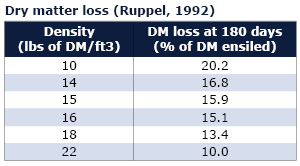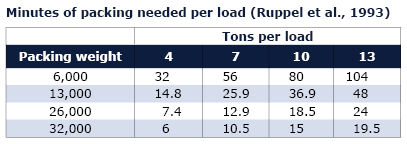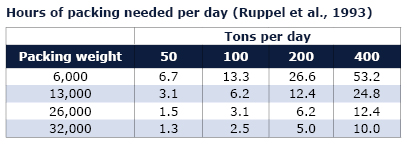
Bunker density: Are you ahead of the pack? Ask that question now
 By the Vita Plus Loyal Dairy Team Managing your forage program is a challenging job and has many components. Selecting the right hybrids, managing your equipment or custom harvester and selecting the proper harvest time are all very important, but, when the weather breaks and the tractors are running, are you paying close enough attention to your packing density? It may seem like it’s a long way off, but setting your harvesting and packing goals now will provide you with the guidance you need as things get busy. Why it’s important There are three main reasons why you should have a well packed bunker:
By the Vita Plus Loyal Dairy Team Managing your forage program is a challenging job and has many components. Selecting the right hybrids, managing your equipment or custom harvester and selecting the proper harvest time are all very important, but, when the weather breaks and the tractors are running, are you paying close enough attention to your packing density? It may seem like it’s a long way off, but setting your harvesting and packing goals now will provide you with the guidance you need as things get busy. Why it’s important There are three main reasons why you should have a well packed bunker:
- The denser the forage, the less air that is able to enter and contribute to dry matter loss during filling, storage and feedout
- A higher density increases the capacity of your silo
- A well packed bunker is safer for you and your employees
Dry matter loss Harvesting at proper moisture, rapid harvesting and filling, and covering your bunker immediately with plastic are all important practices to limit oxygen in your forage during storage. Research done at Cornell University proves that bunker density is another important factor. Dr. Ruppel was able to equate average dry matter loss in respect to bunker density as shown in the table below.  Based on this information, bunkers should have at least 15 pounds of DM per cubic foot with exceptional bunkers having over 20 pounds of DM per cubic foot. Contributing factors Many factors come into play when trying to achieve high densities in your bunkers. With more custom harvesting, one of the hardest factors to manage is forage delivery rate. The University of Wisconsin suggests that the fill rate (tons/hour) should not exceed the tractor weight divided by 800. Here are two tables to help you calculate the amount of weight you need based on your delivery rate:
Based on this information, bunkers should have at least 15 pounds of DM per cubic foot with exceptional bunkers having over 20 pounds of DM per cubic foot. Contributing factors Many factors come into play when trying to achieve high densities in your bunkers. With more custom harvesting, one of the hardest factors to manage is forage delivery rate. The University of Wisconsin suggests that the fill rate (tons/hour) should not exceed the tractor weight divided by 800. Here are two tables to help you calculate the amount of weight you need based on your delivery rate: 
 Adding weight to your packing tractor or adding another packing tractor will help with packing efficiency. As forage comes in, it should be spread in thin layers, no more than 6 to 12 inches, and the tires of the tractor should pass over the entire surface before the next layer is distributed. Other factors that can have a major impact on your final density include maturity, dry matter, chop length, corn silage processor and the storage unit. Central Wisconsin survey Dairy specialists from Vita Plus Loyal conducted a survey of bunker densities this past winter to help improve forage programs. Samples were taken from 32 bunkers and piles. An average of 16.8 pounds of DM per cubic foot was seen across all bunkers with a range of 11.3 to 24.1 pounds DM of per cubic foot. The average haylage density was 16.4 pounds of DM per cubic foot and the average corn silage was 16.8 pounds of DM per cubic foot. These producers are now able to use this information to focus on improving their bunker densities and use it as a benchmark for improvement. What’s your number? Talk to your Vita Plus consultant about doing a density survey on your farm to find your most limiting factor and to set goals for the future. About the authors: Kim Bremmer, Eliza Ruzic, Josh Braman, Kristan Noeldner, Steve Radsek and Darci O’Brien make up the Vita Plus Loyal Dairy Team. With more than 30 years of experience, the Loyal team is proud to work with central Wisconsin dairy producers and offer cutting edge, nutrition, technology and management expertise. Consultants join your team to get an in-depth understanding of your farm and goals and design customized solutions to meet your needs. As employee owners, their actions are guided by the Vita Plus Values of safety, teamwork, commitment, quality, communication, attitude and performance. They understand their success depends on the success of your farm and they’re excited to work with you every step of the way.
Adding weight to your packing tractor or adding another packing tractor will help with packing efficiency. As forage comes in, it should be spread in thin layers, no more than 6 to 12 inches, and the tires of the tractor should pass over the entire surface before the next layer is distributed. Other factors that can have a major impact on your final density include maturity, dry matter, chop length, corn silage processor and the storage unit. Central Wisconsin survey Dairy specialists from Vita Plus Loyal conducted a survey of bunker densities this past winter to help improve forage programs. Samples were taken from 32 bunkers and piles. An average of 16.8 pounds of DM per cubic foot was seen across all bunkers with a range of 11.3 to 24.1 pounds DM of per cubic foot. The average haylage density was 16.4 pounds of DM per cubic foot and the average corn silage was 16.8 pounds of DM per cubic foot. These producers are now able to use this information to focus on improving their bunker densities and use it as a benchmark for improvement. What’s your number? Talk to your Vita Plus consultant about doing a density survey on your farm to find your most limiting factor and to set goals for the future. About the authors: Kim Bremmer, Eliza Ruzic, Josh Braman, Kristan Noeldner, Steve Radsek and Darci O’Brien make up the Vita Plus Loyal Dairy Team. With more than 30 years of experience, the Loyal team is proud to work with central Wisconsin dairy producers and offer cutting edge, nutrition, technology and management expertise. Consultants join your team to get an in-depth understanding of your farm and goals and design customized solutions to meet your needs. As employee owners, their actions are guided by the Vita Plus Values of safety, teamwork, commitment, quality, communication, attitude and performance. They understand their success depends on the success of your farm and they’re excited to work with you every step of the way.
| Category: |
Dairy Performance Forage harvesting Forage storage and management |

